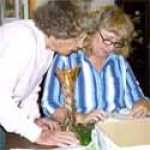Ramping up the Chase County Museum
The new ramp project at the Chase County Museum in Champion not only makes the museum accessible to visitors with handicaps, it also creates a feeling of coherence among the museum's buildings.
The museum consists of the original Champion High School and newer frame and metal buildings on the east. The new ramp was built inside a new corridor that connects the high school to the middle building which is already connected to the east building.
Museum volunteer Kay Gleason said a wall of windows on the east side of the high school was removed to build the connecting corridor. Kay said museum coordinators saved the old windows to make display cases.
Kay said, "When we started out, the high school and the basement were all we had."
Volunteer Murlena Beard said the museum started in the high school building in 1965. It eventually expanded into two new buildings on the east, leaving the high rather school isolated. The new hallway/ramp acts as a bridge between what Murlena laughingly calls "the upstairs" and the "downstairs," and reconnects the high school to the expansions. Several large display cases were moved from the high school to the hallway, freeing up space in the high school. "We always try to keep in mind where a wheelchair can go," Murlena said.
Visitors now move easily from one display to another in each of the three buildings and in the hallway.

The high school now houses an "information center," Murlena said, and the east building has a theater nook for watching videos.
"We saved, and saved, and saved, and saved money for the new hallway," Kay said. Museum officials also anticipate a donation from an estate that will help with funding, Murlena said.
The museum is open Sundays from 1:30 p.m. until 4:30 p.m. MT., and a local artist, collector or crafts person is featured each week.
Get the point?
Rod Fuller's eyes brightened as he sorted through arrowheads and points that Peggy Fitzke's grandfather, Warren Earl, found southwest of Champion many years ago.
A Folsom point ... moss agate ... Knife River flint ... "Material matters," Fuller said. "Some materials are much more collectible than others."
Fuller told Peggy and Russ Fitzke and other visitors at the museum in Champion it is fascinating to know how far a stone traveled before being made into points. "Collectors feel the Indians had a trade network among themselves," Fuller said. "Alibates flint is found only in the Panhandle of Texas," he said, "and arrowheads of alibates are found in Canada."
Fuller has an extensive collection of Indian artifacts and once sold and traded pieces from his collection. "I've never sold an artifact I didn't regret selling later," he laughed. "I don't sell anything anymore."
But Fuller loves to talk about his artifacts and generously shares his knowledge with others. For more information on Indian artifacts, contact Fuller in Imperial, (308) 882-7700.
